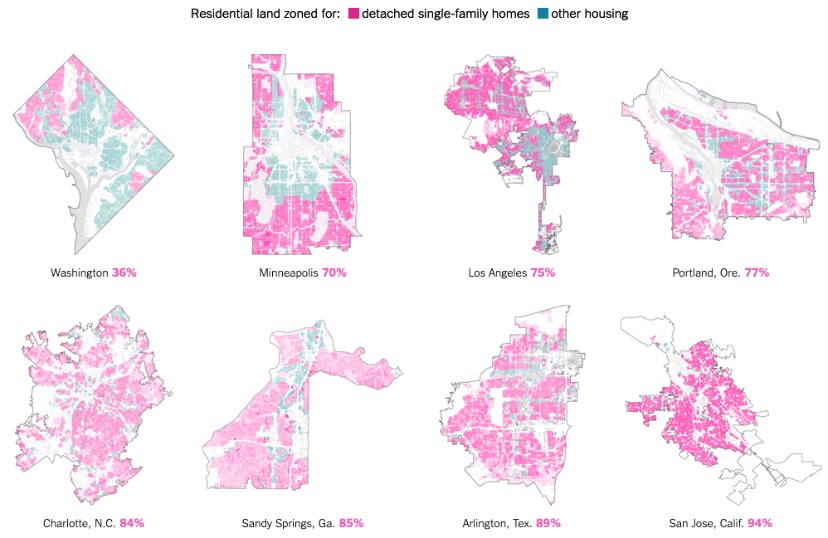There are obvious reasons the median home price in California is $544,900, whereas in the United States it is only $220,100. In California, demand exceeds supply…
— from an article by Hans Bader on LibertyUnyielding.com, April 2019.
Yesterday in Part Six, I mentioned a few building design requirements that we find in the Town of Pagosa Springs Land Use and Development Code (LUDC).
I suggested that many of the LUDC’s building design requirements are aimed, not at the health and safety of its residents, but at aesthetic concerns… at a desire to change Pagosa Springs from the funky, working class town it has historically been, into a tourist-friendly mecca that attracts wealthy retirees and well-paid technology professionals working remotely.
The paragraph I quoted yesterday is only one of a myriad LUDC design requirements that make affordable housing nearly impossible to build in Pagosa Springs.
Some of the most oppressive regulations are found in the Zoning section of the LUDC. The only zone where multi-family apartments are “allowed by right”, for example, is the R-22 zone, which (by my estimation) applies to less than 10 percent of the residential neighborhoods in the town.
We can easily understand why a municipal planning organization would want to prohibit affordable housing in as many places as practical — if your primary goal is to “preserve the existing character of the town” while at the same time making the town “more attractive” to people with plenty of money.
And this is not an uncommon approach to urban planning. Towns and cities all over the US have been (unintentionally) prohibiting affordable housing for decades now, using many of the same requirements we see in Pagosa’s LUDC. In the quote at the beginning of this editorial, the writer notes the skyrocketing cost of housing in California, due to lack of supply. The median price of a California home is apparently more than $540,000, more than twice the national average.
Realtor Lee Riley, writing in the Daily Post last month, posted this graph of the skyrocketing home prices in Archuleta County — which have apparently doubled since 2012:
For the first time ever, our median home price in 2020 exceeded $400,000. A median-priced condo is approaching $250,000. California, here we come.
Some communities have recognized the fact that over-regulation of the housing industry works just fine for wealthy people, and not so well for the working class — the folks who actually keep the local economy running.
From an article by reporter Henry Grabar, in Slate magazine, December 2018:
Minneapolis will become the first major U.S. city to end single-family home zoning, a policy that has done as much as any to entrench segregation, high housing costs, and sprawl as the American urban paradigm over the past century.
On Friday, the City Council passed Minneapolis 2040, a comprehensive plan to permit three-family homes in the city’s residential neighborhoods, abolish parking minimums for all new construction, and allow high-density buildings along transit corridors.
“Large swaths of our city are exclusively zoned for single-family homes, so unless you have the ability to build a very large home on a very large lot, you can’t live in the neighborhood,” Minneapolis Mayor Jacob Frey told me this week. Single-family home zoning was devised as a legal way to keep… minorities from moving into certain neighborhoods, and it still functions as an effective barrier today.
In my opinion, the fact that the Town prohibits truly affordable housing — such as multi-family apartments — in 90% of its neighborhoods was not based on a desire for racial segregation. In my opinion, the zoning in Pagosa Springs was created with the belief that prohibiting affordable housing would benefit the community, overall…. that it would ultimately make us all ‘wealthier’, as time went along.
That’s not how it has turned out.
The rich have gotten richer. The poor have gotten poorer.
It appears that Minneapolis is trying to change that pattern. Other cities are also getting rid of ‘single family zoning’… but the disease goes deep, especially in some of America’s largest cities.

Zoning is just one sticky LUDC problem facing a mountain community that has put numerous ‘positive sounding’ recommendations in the official 2018 Comprehensive Plan:
…9. Consider studying the impact of short- term rentals on long-term affordability to understand and inform local policy.
10. With Archuleta County, collaborate to create an environment that supports affordable housing development and home buying through resource allocation, LUDC amendments, and policy.
11. Create a development environment that facilitates housing and educates the development community on housing opportunities, new regulatory changes that encourage housing and Comprehensive Plan policies that support housing projects.
12. Provide financial resources for housing: consider excise tax, use tax, dedicated sales, property, lodging tax, and/or linkage fees in collaboration with the County.
13. Encourage and support the development of 9% Low Income Housing Tax Credit rental project with fee waivers, land dedication, infrastructure costs and strong community support…
When I reviewed the Comp Plan recently, I counted at least 40 recommendations related to those quoted above, aimed at creating a livable community for all segments of the population.
But it’s one thing to speak or write encouraging words about demographic diversity, and quite another to make significant changes in the way government acts. Governments tend to get stuck in the ‘status quo’, trying to avoid ‘rocking the boat’. I guess we all do.
But the boat needs some rocking. Desperately.
Here’s a quote from yesterday’s StrongTowns.org article by Daniel Herriges about how housing crises were addressed in the past — before professional developers and planning departments took control of everything. You can read his full article here, if you haven’t already.
Chicago added a million people between 1850 and 1890, and another two million by 1930. How did 19th century cities grow in the staggeringly fast way they did, without a huge class of professional developers, architects, planners, etc? The answer is amateur developers.
An historical “swarm” of amateur or small-scale developers, investors, and homeowners, in Mr. Herriges’ view, who were “allowed” to address the need for housing.
Can America in general — and Pagosa Springs in particular — change their land use policies, to ensure everyone can afford a roof over their head?
Before it’s too late?



